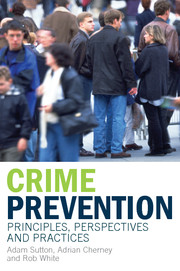8 - Dealing with social disorder
from PART 2 - PRACTICE
Summary
Introduction
This chapter will discuss the following topics:
the importance of multipronged approaches and social inclusion;
the ambiguities of public space;
graffiti and social disorder;
youth gangs and ethnic conflicts; and
unexpected disruptions to the community.
Much public consternation about crime stems from experience and perceptions of disorder or anti-social behaviour in public places. Indeed, when people think of ‘crime’, very often they mean ‘street crime’ – activities generally associated with street level interactions, events and situations.
As discussed in Chapter 4, the implementation of CPTED measures has generally revolved around crime prevention in public places. This is because many perceived and actual crime problems that local government and the police are required to address relate to contestations over public and community spaces. The high profile of social disorder in public places, in both popular consciousness and crime prevention agendas, means that relevant measures warrant further dedicated discussion.
The aim of this chapter, therefore, is to explore further how crime prevention applies to public spaces and, in particular, cityscapes such as streets, public buildings and parks. Building on discussions in the last chapter, we want to demonstrate that crime prevention is basically about making life safer and better, and that we can do this by taking a holistic view of social contexts and interactions. Ensuring community wellbeing demands an appreciation of the physical, social and cultural dimensions of local environments.
- Type
- Chapter
- Information
- Crime PreventionPrinciples, Perspectives and Practices, pp. 135 - 154Publisher: Cambridge University PressPrint publication year: 2008



